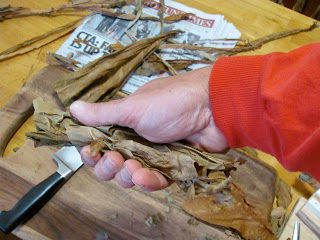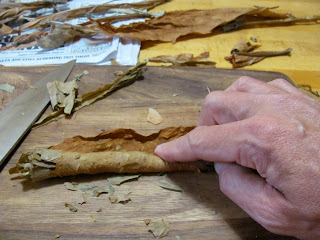Tobacco varieties we grew
In response to a question about rolling cigars on this post, my brother Chris steps in to guest post. Take it away...
So after reading everything I could on the internet, and still not fully sure what I was doing, I decided to try my had at rolling a cigar.
First step - Create a form for the cigars to be pressed into to make a somewhat uniformly sized cigar.
Second step - Find a binder wrapper. This is the initial leaf that's used to wrap the filler to create your rough cigar. Even though we had 3 types of leaves, I found it was easiest just to find a leaf that was in good enough shape (no holes or tears, as well as being pliable enough roll).
Pause while H2 inserts a photo of Chris's first drying step--hung them in his garage (hi Elvis). When they started getting dry he moved the leaves to his cellar, where there's more humidity, keeping an eye out for mold, though none appeared. This photo illustrates how tobacco grows in different-sized leaves, some better for use as a wrapper. (It also illustrates how nice it is to have a garage to store stuff in.)
Third step - Filler. Some sites recommended cutting the filler to create a more uniform cigar. But I hate to chew a cigar with cut tobacco, so I opted to use the full leaf. I grabbed enough leaf, hoping it would fit in the mold. Wrapped that leaf in the wrapper (the initial roll needs to be pretty tight), glued it with egg white, and pressed it into the form. Some seemed a little loose, others I needed to really press in. I guess the correct amount of leaf comes from experience.
Fourth step - Pressure. After filling the form with 10 cigars, place a piece of wood on top and press. The cigars are left in the form for a few days to dry. Some sites say to put the forms in the oven on low for an hour to dry, but I just let them dry naturally.
Last step - Final wrap. For the final roll, I sprayed the leaves (probably should spray the leaves for the initial roll, too) with a sprayer and let them soak up the water. This made them much easier to work with. I had enough good leaves to make a smooth final wrap.
Postprandial Thanksgiving cigars






















